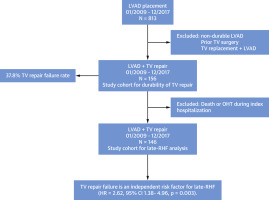当前位置:
X-MOL 学术
›
JACC Heart Fail.
›
论文详情
Our official English website, www.x-mol.net, welcomes your feedback! (Note: you will need to create a separate account there.)
Durability and Efficacy of Tricuspid Valve Repair in Patients Undergoing Left Ventricular Assist Device Implantation.
JACC: Heart Failure ( IF 13.0 ) Pub Date : 2019-12-11 , DOI: 10.1016/j.jchf.2019.08.016 Yaron D Barac 1 , Alina Nicoara 2 , Muath Bishawi 1 , Jacob N Schroder 1 , Mani A Daneshmand 1 , Nazish K Hashmi 2 , Eric Velazquez 3 , Joseph G Rogers 3 , Chetan B Patel 3 , Carmelo A Milano 1
JACC: Heart Failure ( IF 13.0 ) Pub Date : 2019-12-11 , DOI: 10.1016/j.jchf.2019.08.016 Yaron D Barac 1 , Alina Nicoara 2 , Muath Bishawi 1 , Jacob N Schroder 1 , Mani A Daneshmand 1 , Nazish K Hashmi 2 , Eric Velazquez 3 , Joseph G Rogers 3 , Chetan B Patel 3 , Carmelo A Milano 1
Affiliation

|
OBJECTIVES
This study sought to determine the durability of tricuspid valve repair (TVr) performed concurrently with left ventricular assist device (LVAD) implantation and its association with the development of late right heart failure (RHF).
BACKGROUND
Surgical management of tricuspid regurgitation (TR) at the time of LVAD implantation is performed in an attempt to reduce the occurrence of postoperative RHF. Limited data exist regarding the durability of TVr in patients with LVAD as well as its impact on development of late RHF.
METHODS
A retrospective review was conducted of consecutive adult patients who underwent durable LVAD implantation and concurrent TVr at the authors' institution between 2009 and 2017. Late RHF was defined as readmission for HF requiring inotropic or diuretic therapy. TVr failure was defined as moderate or severe TR at any follow-up echocardiographic examination after LVAD implantation.
RESULTS
A total of 156 patients underwent LVAD and concurrent TVr during the study. Of the total, 59 patients (37.8%) had a failed TVr. The mean duration of echocardiographic follow-up was 23 ± 22 months. Of the 146 patients who were discharged after the index hospitalization, 53 patients (36.3%) developed late RHF. Multivariate Cox proportional hazard analysis demonstrated that TVr failure was an independent predictor of late RHF development (hazard ratio: 2.62; 95% confidence interval: 1.38 to 4.96; p = 0.003).
CONCLUSIONS
Failure of TVr in this cohort occurred at a significant rate. Failure of TVr is an independent risk factor for development of late RHF. Future studies should investigate strategies to reduce recurrence of significant TR.
中文翻译:

三尖瓣修复术的耐用性和有效性在接受左心室辅助装置植入的患者中。
目的本研究旨在确定三尖瓣修复(TVr)与左心室辅助装置(LVAD)植入同时进行的持久性及其与晚期右心衰竭(RHF)发生的关系。背景技术在LVAD植入时进行三尖瓣关闭不全(TR)的外科手术管理,以试图减少术后RHF的发生。关于TVr在LVAD患者中的持久性及其对晚期RHF的影响,存在有限的数据。方法回顾性分析2009年至2017年在作者所在机构接受连续LVAD植入并同时进行TVr的连续成年患者。晚期RHF被定义为需要正性肌力药或利尿剂治疗的HF再入院。LVAD植入后的任何后续超声心动图检查均将TVr衰竭定义为中度或重度TR。结果在本研究中,共有156例患者接受了LVAD和同时TVr治疗。在所有患者中,有59名患者(37.8%)的TVr失败。超声心动图随访的平均持续时间为23±22个月。在146例指数住院后出院的患者中,有53例(36.3%)出现了晚期RHF。多元Cox比例风险分析表明TVr失败是RHF晚期发展的独立预测因素(风险比:2.62; 95%置信区间:1.38至4.96; p = 0.003)。结论该人群TVr失败的发生率很高。TVr的失败是晚期RHF发生的独立危险因素。
更新日期:2019-12-11
中文翻译:

三尖瓣修复术的耐用性和有效性在接受左心室辅助装置植入的患者中。
目的本研究旨在确定三尖瓣修复(TVr)与左心室辅助装置(LVAD)植入同时进行的持久性及其与晚期右心衰竭(RHF)发生的关系。背景技术在LVAD植入时进行三尖瓣关闭不全(TR)的外科手术管理,以试图减少术后RHF的发生。关于TVr在LVAD患者中的持久性及其对晚期RHF的影响,存在有限的数据。方法回顾性分析2009年至2017年在作者所在机构接受连续LVAD植入并同时进行TVr的连续成年患者。晚期RHF被定义为需要正性肌力药或利尿剂治疗的HF再入院。LVAD植入后的任何后续超声心动图检查均将TVr衰竭定义为中度或重度TR。结果在本研究中,共有156例患者接受了LVAD和同时TVr治疗。在所有患者中,有59名患者(37.8%)的TVr失败。超声心动图随访的平均持续时间为23±22个月。在146例指数住院后出院的患者中,有53例(36.3%)出现了晚期RHF。多元Cox比例风险分析表明TVr失败是RHF晚期发展的独立预测因素(风险比:2.62; 95%置信区间:1.38至4.96; p = 0.003)。结论该人群TVr失败的发生率很高。TVr的失败是晚期RHF发生的独立危险因素。



























 京公网安备 11010802027423号
京公网安备 11010802027423号